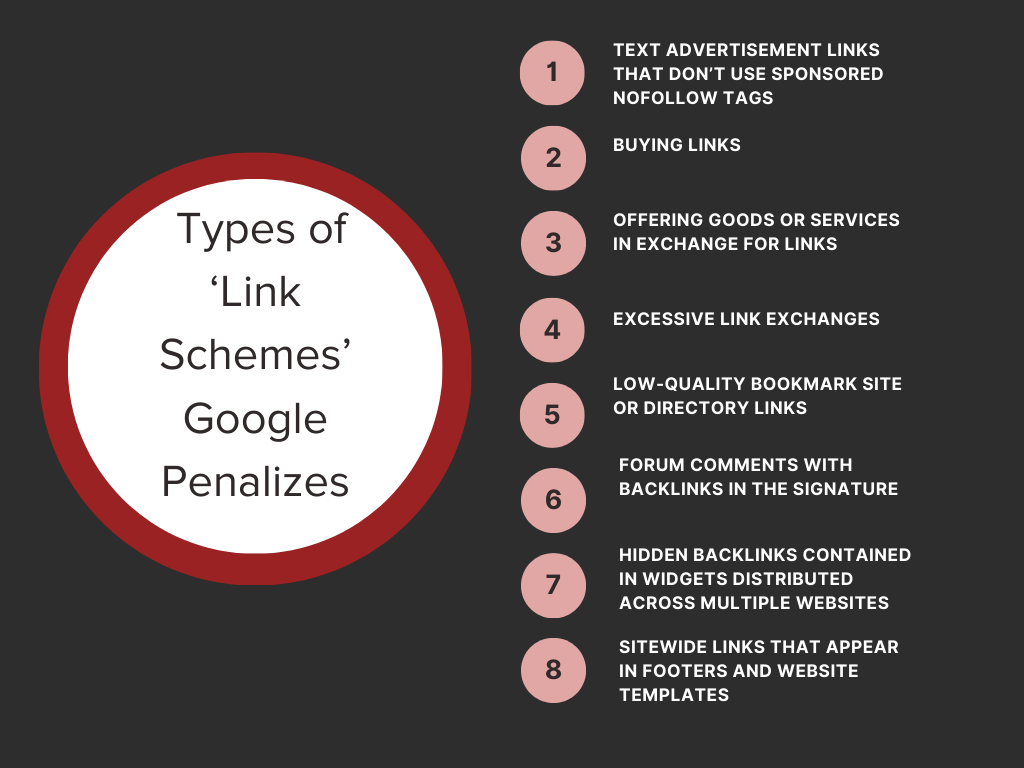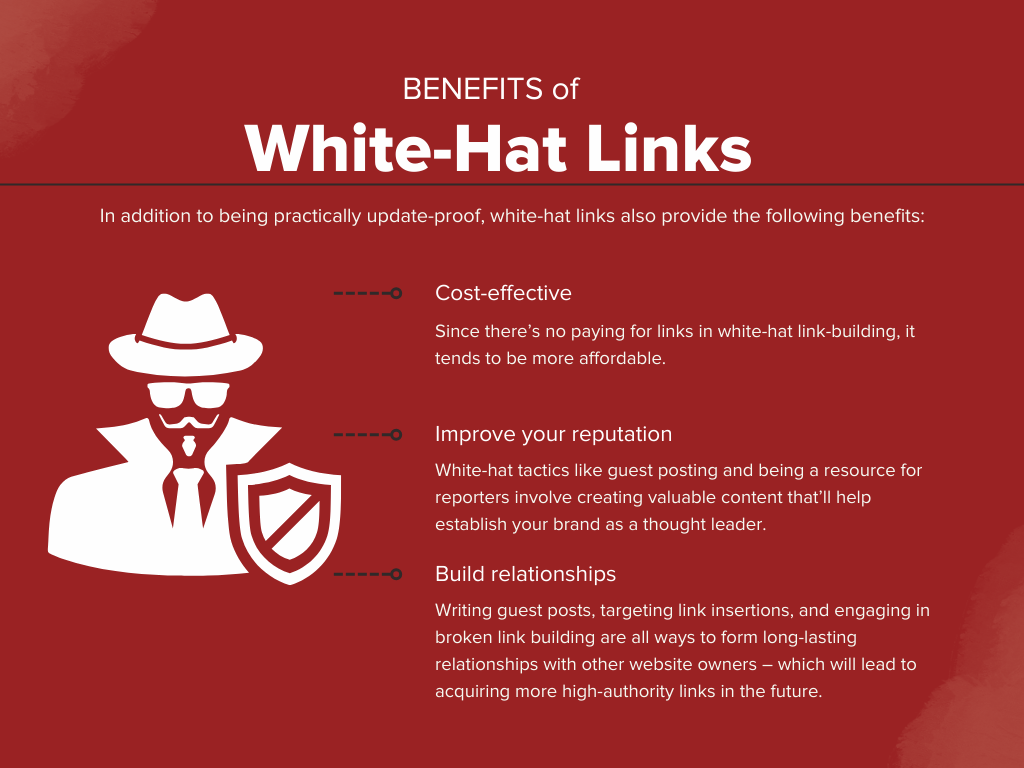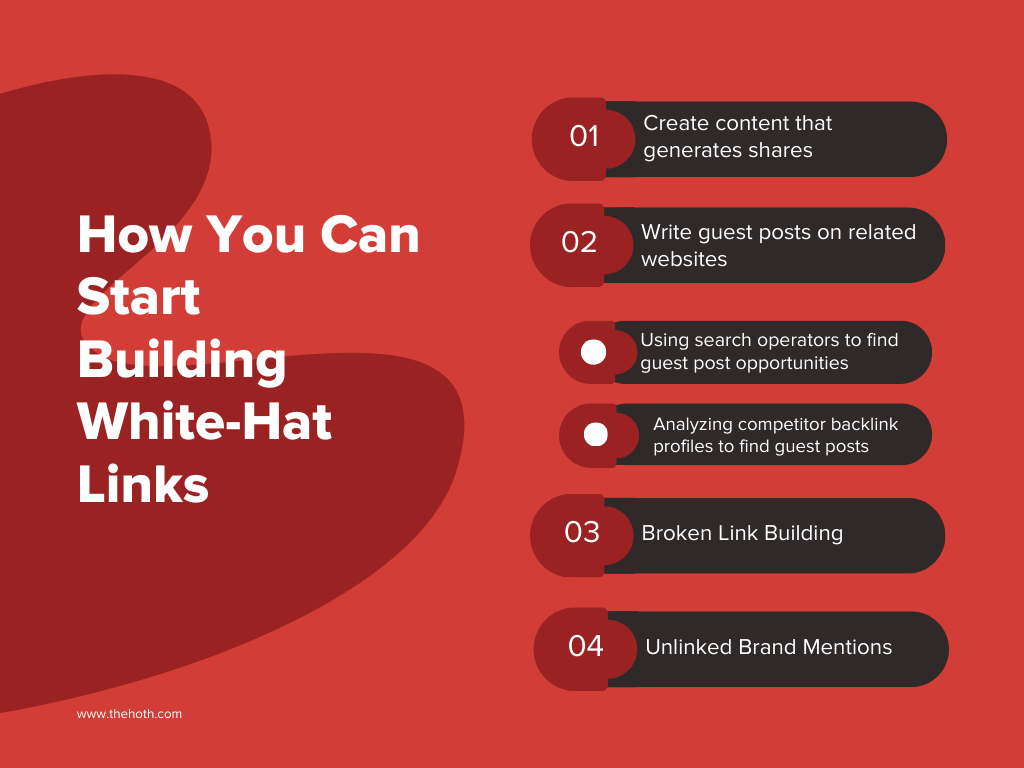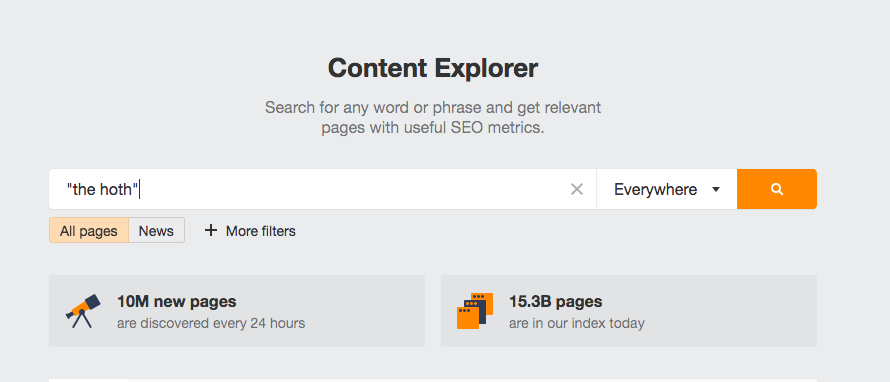If you spend any bit of time reading SEO blogs, you’re bound to read about different ‘hats’ at some point, such as building white-hat links.
White hat this, black hat that, but what does the color of your hat have to do with ranking on Google?
The whole white-hat/black-hat dynamic is a reference to early American Western movies, where the hero wore a white hat, and the villain wore a black hat.
In the SEO world, the color of the hat you wear represents whether you adhere to Google’s Search Essentials (formerly Webmaster Guidelines) when optimizing your content.
For example, ‘white-hat’ practices include:
- Creating excellent content that provides value to your audience.
- Using keywords organically in your content (avoiding spam).
- Naturally acquiring backlinks due to the strength of your web pages.
These all follow Google’s guidelines, and they align with its goals as a search engine – which is to provide users with valuable, trusted content.
Your spiffy white hat will turn black if you don’t follow the rules and use frowned-upon tactics like buying backlinks in bulk, spamming keywords, and cloaking.
Choosing to pursue white-hat links will benefit you in the long run when it comes to link-building.
That’s because they’re cost-effective, virtually risk-free, and can help you build long-lasting relationships with other websites in your niche.
Stay tuned to learn how to build white-hat links for your website.
White-Hat Links vs. Black-Hat Links: What’s the Difference?
White-hat and black-hat links have some distinct differences, but let’s define them first.
What are white-hat links?
A white-hat link is a backlink that you earn organically, meaning that other websites choose to link to your content based on its merit alone.
Your methods adhere to Google’s (or another search engine’s) search guidelines, and your main focus is on creating high-quality, relevant content that’s truly helpful to your audience.

White-hat link-building methods include the following:
- Writing guest posts on high-quality sites within your industry.
- Creating resources that generate lots of shares, like infographics and videos.
- Conducting outreach (without offering money) and building relationships with news sites, media outlets, and related websites that aren’t direct competitors.
- Naturally attracting backlinks due to the strength of your blogs, guides, social media posts, and other types of content.
What are black-hat links?
Black-hat links are acquired through manipulative tactics that A) violate search engine guidelines and B) don’t provide any value to users.
These tactics aren’t concerned with playing by Google’s rules or catering to their target audience. Instead, they only aim to game the system and artificially boost search rankings and organic traffic generation.
Google’s guidelines make it explicitly clear that they don’t tolerate black-hat link-building tactics, which they refer to as link schemes.

The black-hat game is a notoriously risky one, as Google actively penalizes websites that it finds using manipulative tactics.
Punishments and consequences of black-hat link-building include:
- Severe search engine penalties like getting a page (or your entire site) removed from Google’s index
- Damage to your website’s reputation, which may cost you valuable backlink opportunities in the future
- Significant drops in organic traffic

Here’s an overview of the types of ‘link schemes’ Google penalizes websites for:
- Text advertisement links that don’t use sponsored nofollow tags
- Buying links
- Offering goods or services in exchange for links
- Excessive link exchanges (trading links exclusively with another website in bulk)
- Low-quality bookmark site or directory links
- Forum comments with backlinks in the signature
- Hidden backlinks contained in widgets distributed across multiple websites
- Sitewide links that appear in footers and website templates
Participating in any of these link-building tactics will earn you a hat black enough to make Lee Van Cleef jealous.
Why is that?
It’s because black-hat link tactics rely on trickery instead of gaining backlinks based on the merit of their content.
Google takes this very seriously because its reputation is on the line.
If they were to let every black hat tactic fly, their search results would be chock full of irrelevant, low-quality results that wouldn’t satisfy their users’ intent.
That’s why they use SpamBrain, their AI-powered algorithm that hunts down spammy websites and links.
On the other hand, white-hat link builders use the quality of their content to acquire links, which is what Google wants.
While strictly using white-hat tactics is a bit difficult and time-consuming, it is possible – and can yield many benefits.
Are White-Hat Links Worth the Trouble?
The reason many SEOs give into the dark side and use black-hat techniques is how hard it can be to build links without violating any guidelines.
In fact, according to a study by Conductor, 41% of companies consider link-building as the most difficult aspect of SEO.
Even the most talented link builders tend to use a mix of white, gray, and black-hat techniques out of necessity for this reason.
| What are gray-hat techniques? Sometimes a link-building tactic is ambiguous in that it doesn’t really break Google’s search guidelines, but it certainly doesn’t follow them either. Examples of gray-hat tactics include buying backlinks, paying for reviews, and creating content that doesn’t offer much value (but isn’t completely useless, either). |
Yet, white-hat links are undoubtedly the safest and most powerful type of links you can acquire, and they’re the most likely to withstand new Google algorithm updates.
For instance, the Link Spam Update from December 2022 negated the impact paid backlinks had on SEO profiles, and the effects were drastic on websites that had bought lots of links.
Backlink profiles consisting entirely of white-hat links, on the other hand, were completely unaffected.
Benefits of white-hat backlinks
In addition to being practically update-proof, white-hat links also provide the following benefits:
✨Cost-effective. Black-hat link tactics tend to involve shelling out cash for links, which is expensive and wasteful if the links don’t pan out. Since there’s no paying for links in white-hat link-building, it’s the more affordable option.
✨Improve your reputation. White-hat tactics like guest posting and being a resource for reporters involve creating valuable content that’ll help establish your brand as a thought leader. Conversely, black-hat tactics will actively harm your reputation if you get caught, which can spell disaster for your future outreach efforts.
✨Build relationships. Writing guest posts, targeting link insertions, and engaging in broken link building are all ways to form long-lasting relationships with other website owners – which will lead to acquiring more high-authority links in the future. Also, as you continue to grow and expand your network, it’ll become increasingly easier to generate the backlinks you need.
White-hat links provide many benefits and involve virtually zero risks for digital marketers.

How You Can Start Building White-Hat Links
Are you ready to don a white hat and save your website from costly penalties?
Then, you’ll need a reliable bag of tricks (and maybe a six-shooter) to use if you want to see better SERP rankings.
While it’s true that white-hat link-building techniques can take some time, once they get going, they tend to keep on giving.
Here’s a look at the most effective ways to build white-hat links.
Create content that generates shares

Let’s begin by looking at the link-building tactic that Google values the most: creating high-value content that other websites can’t wait to share.
This makes Google happy because you’re acquiring backlinks in a 100% natural way. Not only did you not have to offer website owners any money to link to your content, you didn’t even have to send them an outreach email.
An example would be creating a fun infographic that provides relevant statistics for your industry.
Bloggers are always looking for statistics and visually engaging infographics to share in their posts. By creating a stellar infographic containing relevant statistics, you’ll be doing them a huge favor.
As a result, they’ll link to your content without you having to lift a finger, and you’ll start raking in backlinks like mad.
| Pro tip: Certain types of content generate more backlinks than others. Research shows that ‘why’ posts, ‘what’ posts, and infographics are the most heavily linked to types of content online – followed shortly by how-to posts, videos, and listicles. |
Resource pages, ultimate guides, and free tools also generate lots of shares and backlinks, especially if you go into lots of detail.
We can attest to this, as our free tools generate thousands of backlinks for us. For example, our backlink checker tool currently has 1,932 backlinks coming from 219 referring domains:

If possible, try to develop a free tool for your target audience.
Also, one content type that’s scarcely used but is still excellent for generating shares is surveys.
Conducting a relevant survey in your field will provide original, relevant statistics for your audience and other professionals in your industry. A survey like this is a goldmine for generating shareable content, as you can mention the findings of the survey in:
- A dedicated blog post
- An infographic (containing stats that your competitors won’t have yet)
- A video
- A whitepaper
As you can see, one survey can turn into numerous content types, all of which have the potential to generate backlinks.
Another benefit of creating linkable assets is that they will keep generating links for you over time, especially if the topics are evergreen.
Write guest posts on related websites
Another classic white-hat link-building tactic is to write guest blogs on other websites in your industry.
This involves sending outreach emails to website owners, but you don’t offer money or products/services in exchange for a link.
Instead, you’re requesting to write a guest blog post on their website to provide value to their audience. For this reason, guest posting is not considered a link scheme.
The challenge comes in finding websites in your niche that accept guest posts and then getting one of those websites to allow you to write one.
The site owner benefits because you’re providing them with a piece of content they don’t have to create, and you benefit via a backlink on their site that points to yours.
Using search operators to find guest post opportunities
There are a few ways to hunt down websites that accept guest posts, and using Google search operators is one of the most popular.
What are search operators?
They’re special phrases you type into Google to receive unique search results. The most popular search operator for guest posts looks something like this:
Industry/niche keyword + “guest post”
It’s crucial to use the ‘+’ sign and quotation marks for the search operator to work properly.
However, you shouldn’t stick with just one, as you probably won’t find many guest post spots that way. Here are some more suggestions:
- Gardening + “guest blog”
- Gardeners + “guest blogger”
- Gardening tips + “guest column”
- Gardening + “guest article”
- Pruning + “guest author”
- Planting + “write for me”
- Gardening blog + “write for us”
- Gardening magazine + “become a contributor”
- Gardening journal + “contribute to this site”
Plugging these into Google should provide a viable list of websites that you can contribute guest posts to, but sometimes it takes a little experimenting with the search operators to find the best opportunities.
We recommend compiling the most promising guest post opportunities into a spreadsheet to make the outreach process easier.
Analyzing competitor backlink profiles to find guest posts
If you’re burned out on using search operators, you can also analyze competitor backlink profiles to discover where they’re writing guest posts.
Take to Google and type in your most important keywords, then run the top #5 results through our free Backlink Checker tool.
From there, dig through their link profiles to find guest blogs, and then add those websites to your list of guest post opportunities.
Sticking with the gardening example from before, let’s give this a whirl.
If you sold gardening tools, one of your top competitors would be Raw Rutes, so let’s peep at their backlinks.
After doing some digging, there’s a backlink from a site called Gardening Know How where Raw Rutes has been writing some guest blogs.

Voila, now you have a website in your niche that you know accepts guest posts, so you’d be able to pitch them guest blog ideas.
Running a domain authority check on each website
Before you start reaching out to each website owner to request a guest post, confirm that they have a strong domain authority score.
What’s that?
Domain authority (DA) is an SEO metric developed by Moz that predicts the likelihood of a website ranking high on the SERPs.
While it’s a third-party metric (not officially created by Google or any other search engine), it’s a reliable judge of the ranking strength of a domain.
A domain authority score is a number from 1 – 100, with 1 being the weakest and 100 being the strongest.
If you write a guest post for a website with very poor domain authority, the backlink placement won’t improve your SERP rankings.
Ideally, you only want to obtain backlinks from trusted, relevant (their content must relate to yours) websites with high domain authority scores.
DA scores above 40 are considered high authority, so look out for those whenever they pop up.
| Pro-tip: Ahrefs has an excellent free Website Authority Checker tool that will let you know the DA score for any website, so be sure to use it when vetting guest post spots. |
Broken link building
This white-hat tactic will provide you with a backlink while providing the internet with a great service by removing a busted link.
Broken links pop up on websites all the time, usually when a site owner moves or deletes a page without updating the hyperlink.
Broken links on your website are a no-no that you should always fix. However, broken links on other websites in your niche present golden link-building opportunities.
How’s that?
Let’s say that a website in your niche has a link to a blog post that’s broken. Not only that, but it just so happens that you have a blog covering the same topic on your website, which would be the perfect replacement.
By sending an outreach email to the site owner, you can offer to fix the broken link by linking to your blog instead.
This technique tends to work because broken links are bad for SEO, and offering a replacement link provides a quick fix. That’ll save the site owner the time and hassle of creating a new piece of content to fix the link.
It doesn’t always work, as sometimes the site owner may have moved the post without updating the link, meaning they don’t need anything from you.
However, you should still add it to your white-hat link-building repertoire – as it doesn’t violate any guidelines.
Ahrefs saves the day again, as they have a free Broken Link Checker that will find broken links on any URL you enter. Simply enter a URL, complete the captcha, and presto – you’ll have a breakdown of all the broken links on any given website.
Unlinked brand mentions
The last white-hat link-building tactic we’ll look at is unlinked brand mentions. This is where you find instances where other websites mentioned your brand but failed to provide a backlink – hence the name.
It’s a great technique because it targets websites that have already mentioned your brand, meaning that they’re genuinely interested in what you do.
Ahrefs’ Content Explorer has a nifty feature where you can enter your brand name in quotes, choose ‘In Content’ from the drop-down menu, and then select the highlight unlinked filter.


This will display all your unlinked brand mentions, so get ready to start sending outreach emails.
Sign up for HARO
HARO stands for Help-a-Reporter-Out, and it’s a platform that connects journalists with industry experts for quotes, insights, and stories.
It’s an excellent resource for backlinks since responding to journalists’ queries will score you a backlink in their story (if they choose your reply, that is).
Here’s how HARO works:
- Journalists submit queries detailing the kind of information and expertise they need for their stories.
- Sources (individuals, businesses) with relevant knowledge respond to these queries with pitches, offering their insights and potential quotes.
- If the journalist likes the pitch, they’ll often use the source in their article and possibly provide a backlink to the source’s website.
HARO is 100% a white-hat tactic because it provides value to users through journalists’ stories, so Google has no problem with it. It’s also an excellent opportunity to gain media exposure, earn valuable backlinks, and position yourself as a thought leader in your field.
Here’s how to get started using HARO:
- Sign up: Create a free account on the HARO platform (https://www.helpareporter.com/).
- Set your preferences: Choose categories relevant to your industry and expertise. This determines the types of journalist queries you’ll receive.
- Monitor your inbox: HARO sends out emails three times a day (morning, afternoon, and evening). Scan these quickly for relevant opportunities.
- Craft quick and compelling pitches: When you see a good fit, respond promptly with a concise pitch. Highlight your expertise and how you can uniquely add value to the journalist’s story.
- Follow-up: If you don’t hear back within a reasonable timeframe, a polite follow-up email can be effective, but don’t get pushy!
Run a digital PR campaign
Digital public relations (PR) is where you get in touch with bloggers and online journalists to share relevant information about your organization. The goal is to A) generate backlinks and B) improve your company’s reputation in the eyes of the public.
Digital PR involves conducting outreach to media outlets, news websites, bloggers, and social media influencers.
Here’s how you can use digital PR to boost your SEO:
- Share newsworthy content: The core of digital PR is having something worth sharing. This could be:
- Original research or data
- Expert insights and commentary
- Charitable donations
- Adding a new department/launching a new product
- Announcing new C-suite members (CEO, CFO, CMO, etc.)
- A unique company announcement
- Thought leadership pieces
- Craft your press release: Write a newsworthy press release and optimize it for online distribution.
- Targeted media list: Build a list of journalists, bloggers, and influencers in your niche who might be interested in your story.
- Outreach: Personalize your pitches when contacting the media. Highlight the value your content offers their audience.
- Track coverage & mentions: Monitor news outlets, social media, and blogs to see who covers your story. Look for backlinks to your website.
Concluding Thoughts: White-Hat Links
If you don’t want Google to penalize your content, it’s best to be like John Wayne and always wear a white hat.
You can build a strong backlink profile that raises zero suspicion by creating valuable content, fixing broken links, and adding backlinks to your existing brand mentions.
Do you need expert link-building services for your website?
Then don’t wait to check out our Link Outreach and Link Insertions Services from The HOTH. Our link-building techniques are squeaky clean, and we’ve helped countless clients dominate the SERPs in their industry, so don’t wait to get in touch now.
[ad_2]
